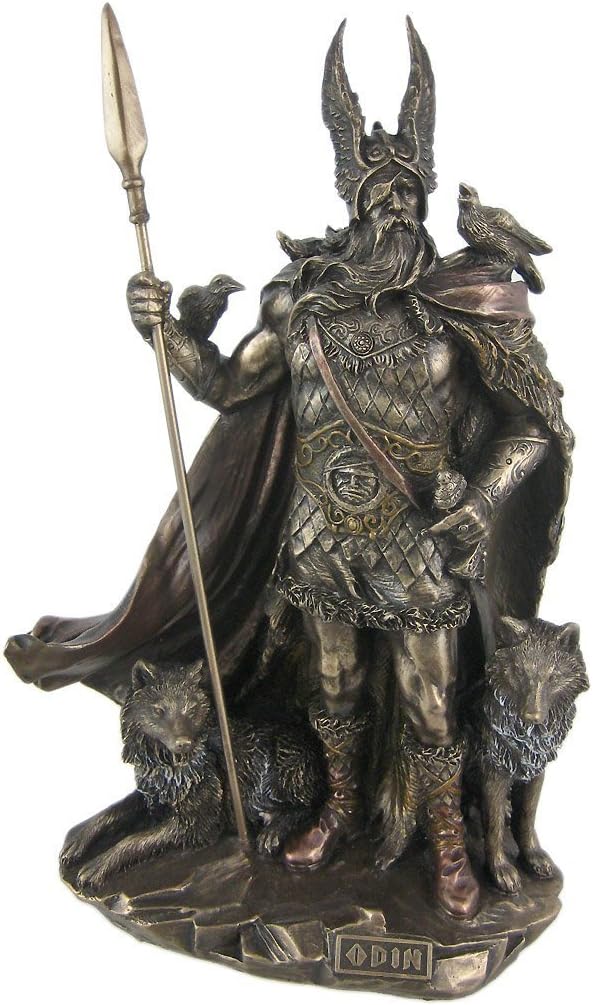About this deal
The Old Norse theonym Óðinn (runic ᚢᚦᛁᚾ on the Ribe skull fragment) [2] is a cognate of other medieval Germanic names, including Old English Wōden, Old Saxon Wōdan, Old Dutch Wuodan, and Old High German Wuotan ( Old Bavarian Wûtan). [3] [4] [5] They all derive from the reconstructed Proto-Germanic masculine theonym *Wōðanaz (or *Wōdunaz). [3] [6] Translated as 'lord of frenzy', [7] or as 'leader of the possessed', [8] *Wōðanaz stems from the Proto-Germanic adjective *wōðaz ('possessed, inspired, delirious, raging') attached to the suffix *-naz ('master of'). [7] Woðinz (read from right to left), a probably authentic attestation of a pre-Viking Age form of Odin, on the Strängnäs stone.
Poyer, A (2015). "The Topographic Settings of Bronze Age Metalwork Deposits in North East England" (PDF). etheses.whiterose.ac.uk. Archived (PDF) from the original on 26 September 2021 . Retrieved 19 March 2021. While this makes Odin seem similar to “father” deities from other mythologies such as Zeus and Ra, he is different from them in several aspects. Unlike those deities, Odin played many roles. Odin – Master of Ecstasy Odin in the Guise of a Wanderer (1886) by Georg von Rosen. Public Domain.The Norsemen worshipped many gods, each of whom had various characteristics, weaknesses and attributes. Based on sagas and some rune stones, details have emerged suggesting that the Vikings believed the gods possessed many human traits and could behave like humans. Music inspired by or featuring the god includes the ballets Odins Schwert (1818) and Orfa (1852) by J. H. Stunz and the opera cycle Der Ring des Nibelungen (1848–1874) by Richard Wagner. [95]
Other Germanic cognates derived from *wōðaz include Gothic woþs ('possessed'), Old Norse óðr ('mad, frantic, furious'), Old English wōd ('insane, frenzied') and Dutch woed ('frantic, wild, crazy'), along with the substantivized forms Old Norse óðr ('mind, wit, sense; song, poetry'), Old English wōþ ('sound, noise; voice, song'), Old High German wuot ('thrill, violent agitation') and Middle Dutch woet ('rage, frenzy'), from the same root as the original adjective. The Proto-Germanic terms *wōðīn ('madness, fury') and *wōðjanan ('to rage') can also be reconstructed. [3] Early epigraphic attestations of the adjective include un-wōdz ('calm one', i.e. 'not-furious'; 200 CE) and wōdu-rīde ('furious rider'; 400 CE). [10]The 11th century Ledberg stone in Sweden, similarly to Thorwald's Cross, features a figure with his foot at the mouth of a four-legged beast, and this may also be a depiction of Odin being devoured by Fenrir at Ragnarök. [81] Below the beast and the man is a depiction of a legless, helmeted man, with his arms in a prostrate position. [81] The Younger Futhark inscription on the stone bears a commonly seen memorial dedication, but is followed by an encoded runic sequence that has been described as "mysterious," [82] and "an interesting magic formula which is known from all over the ancient Norse world." [81] In addition to his role as a creator god, Odin was worshipped as the Norse god of war. For instance, he was seen as a protector of Viking warriors. Additionally, the Norse thought that Odin never lost a battle, with some even believing that it was impossible for the god to lose a battle. Odin was often sought for wise advice by the other gods, heroes, or beings in Nordic legends, and he was often the one to make difficult decisions in complicated situations. The earliest records of the Germanic peoples were recorded by the Romans, and in these works Odin is frequently referred to—via a process known as interpretatio romana (where characteristics perceived to be similar by Romans result in identification of a non-Roman god as a Roman deity)—as the Roman god Mercury. The first clear example of this occurs in the Roman historian Tacitus's late 1st-century work Germania, where, writing about the religion of the Suebi (a confederation of Germanic peoples), he comments that "among the gods Mercury is the one they principally worship. They regard it as a religious duty to offer to him, on fixed days, human as well as other sacrificial victims. Hercules and Mars they appease by animal offerings of the permitted kind" and adds that a portion of the Suebi also venerate "Isis". In this instance, Tacitus refers to the god Odin as "Mercury", Thor as " Hercules", and Týr as " Mars". The "Isis" of the Suebi has been debated and may represent " Freyja". [24] Is the silver figurine from Lejre representing Odin? Freya? Or perhaps a völva, a Viking sorceress? Many interpretations have been put forward
Related:
 Great Deal
Great Deal 